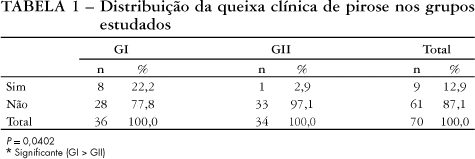BACKGROUND: The abnormalities of swallowing process have multifactor and complex etiologies. The videofluoroscopy has been pointed as the exam of greater utility in diagnostic investigation for these cases. This method, when preceded of an adequate anamnesis, can characterize conveniently the level of the dysfunction and usually identify the cause of abnormality with great precision. AIMS: To study the clinical complaints and findings of the videofluoroscopy examination in patients with deglutition disorders and no clinical evidence associated with neurological disorder, classified into two age groups: adults and older people, and to analyze: symptomatic manifestations, kinds of disorders (oropharyngeal or esophageal) and the capacity of clarifying the clinical complaints through the method of images. MATERIALS AND METHODS: Seventy patients with complaint of the capacity of deglutition were analyzed. They had no clinical evidence of associated neurological syndromes or disorders and were classified into two age groups: adults (GI) - £65 years (n = 36) and older (GII) >65 years (n = 34). All patients were submitted to anamnesis to obtain the information about their complaints concerning deglutition. The complaints were characterized as high or low, according to their predominant location of manifestation. All the patients were submitted to videofluoroscopy of the deglutition; these alterations were characterized as oropharyngeal or esophageal. The capacity of clarifying the clinical complaints by videofluoroscopy was evaluated in both groups. RESULTS: Among the complaints analyzed, the only one in which the statistical analysis presented a significant difference between the groups was the complaint of heartburn, which occurred more often in the group GI - eight patients (22.2%) and GII - one patient (2.9%). In the study of videofluoroscopy, it was observed a higher incidence in the oropharyngeal disorder in group GII - 41.2% while in group GI - 13.9%. As for the esophageal disorder, the incidence was similar in both groups GI - 35.3% and GII - 33.3%. Nineteen patients (52.8%) in GI and 23 (67.6%) in GII had their complaints clarified through the videofluoroscopy. CONCLUSIONS: Under the conditions of this study, it can be concluded that: 1.The clinical complaints associated with the difficulty of deglutition occur at a similar frequency in adults and older people, with the exception of heartburn that occurs in larger number among adults; 2. Older people present a higher incidence of oropharyngeal deglutition problems; 3. The videofluoroscopy of the deglutition represents a method of great importance for the diagnosis, because it allows the identification of morphofunctional disorders that cannot be adequately identified by anamnesis; 4. The capacity of clarifying diagnosis of the videofluoroscopy of the deglutition is higher in the older people group.
Deglutition disorders; Fluoroscopy; Adult; Aged


